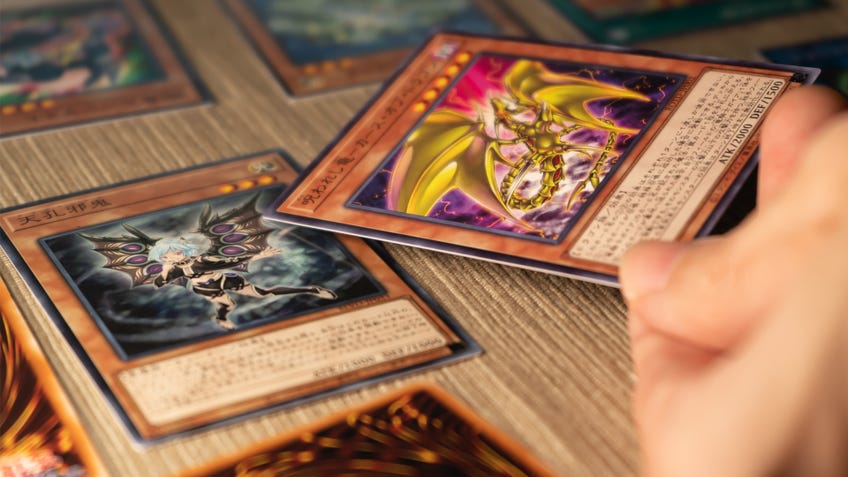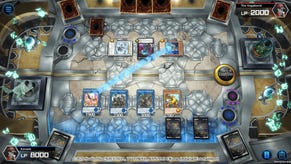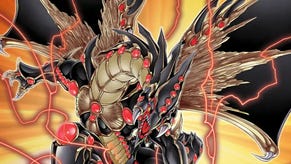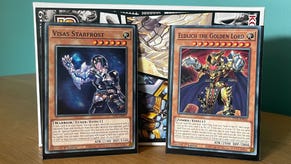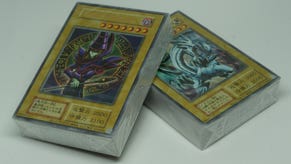As Yu-Gi-Oh! prepares to turn 25, the card game has never felt more welcoming for newcomers
Ample digital offerings, wide card availability and a healthy competitive scene have helped the TCG put its best foot forward a quarter-century in.
Having recently picked up an Analogue Pocket, stumbling upon a copy of one of the old Yu-Gi-Oh! World Championship video games in the process (the 2006 edition specifically), I felt a wave of nostalgia rush over me. The game was released during the peak of my childhood obsession with the card game, long before the responsibilities of age made it difficult to reconnect with this love until many years later. Booting the game felt like a time capsule as I glanced at the decks my childhood self had built on that cartridge. The game represented the days where Yu-Gi-Oh! felt not just exciting but accessible for everyone, a relic from the final moments of the pre-archetype era that made it simple for anyone to pool their cards together for a competitive or casual duel with friends or strangers alike.
As Yu-Gi-Oh! got more complex this changed, and the growing complexity was one reason my childhood self lost interest in the game. Beyond a spell of play during the early 2010s, it took almost a decade to find the time to dedicate to the TCG once again. Even by the time nostalgia fueled this return, those same concerns over complexity and accessibility remained, the introduction of pendulums and the beginning of the Link monster era once again upending the conventions of the game.
For all the complexities remain a constant factor, this intimidating distance between newcomers and the joy of playing Yu-Gi-Oh! has shrunk considerably. In fact, looking back on many of the releases from 2023 as we look ahead to a tentpole anniversary year for the game, Yu-Gi-Oh! has never been more welcoming and accessible to newcomers as it feels today.
This is the result of a change in approach that we covered throughout last year, and comes from a dedicated attempt to revitalise the game and encourage new audiences both old and young to not just try Yu-Gi-Oh!, but enjoy their experience enough to stick around afterwards. It’s a process that first began during the 2010s with the release of various companion games for mobile and other devices, starting with the release of Duel Links and the speedier, simplified physical format of Speed Duel.
We’ve talked about the uncertain existence of the physical incarnation of the format during COVID in the past, but the success of the Duel Links mobile game is undeniable. Far from being nothing more than a healthy revenue stream for Konami as a company, the game brought with it a cohort of new and returning players enthused by the bitesized experience the game offered. Many even made the jump to that physical edition of Speed Duel, a mode that has felt at least partially bolstered by the return of in-person competition.
While far dwarfed by tournaments for the main game, the existence of Speed Duel as side events at YCS tournaments and Remote Duel events alongside the consistent launch of new, reasonably-priced products has cultivated a dedicated community of players supportive of this alternative way to play.

For those looking to get into the game, it remains the cheapest way to get into the game: two sets containing four decks each and everything you need to play were launched in 2023 at under £25 per box, and Konami has already committed to at least one more set in 2024. The reliance on nostalgia with beloved characters as skills and a generally older card pool is no coincidence either, encouraging lapsed players back to the game for a cheaper transitional path back to the main game or a casual way to play the game without being put off by the commitment necessary for main events.
The reliance on nostalgia is no coincidence, encouraging lapsed players back to the game for a cheaper path back to the main game or a casual way to play.
It’s a mode that remains under question due to its lower popularity and the success of Rush Duel in Japan, in particular with the recent introduction of Rush Duel internationally in English for the first time following its introduction to Duel Links as an additional mode. Yet the continued affirmation of this cheaper entry point is worth celebrating, and an uptick in events in 2023 coinciding with the full-scale reintroduction of in-person events is a signal of intent that the company intends to retain a cheaper entry point going forwards, regardless of which format becomes the priority moving forwards.
The announcement of Rush Duel’s introduction to Duel Links came at last year's Yu-Gi-Oh! World Championships. It was an event that not only signalled the grand return of the centrepiece of the competitive calendar, streamed worldwide for audiences on YouTube and Twitch, but affirmed the company’s commitment to reaching players where they are, rather than forcing players to come to them in order to compete. This was the first year a world champion in the mega-hit free-to-play Master Duel was crowned, joining Duel Links as the second digital crown awarded at the event.
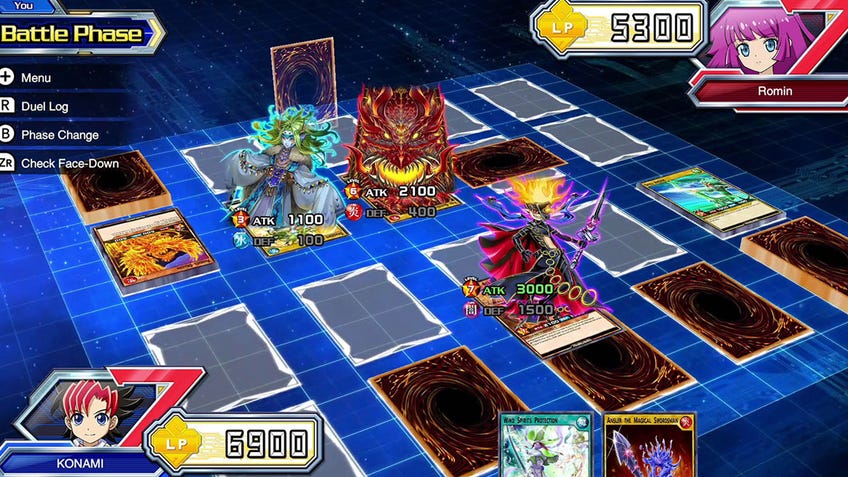
With Duel Links and Master Duel come not just a new legion of champions whose history with the game differs from their TCG counterparts, but offer a new way for those TCG veterans to compete in new ways that keeps the game fresh. Everyone on Team snipehunters had extensive TCG experience prior to Master Duel championship glory, while Joshua Schmidt won the most recent YCS Bologna just months after their Championship-crowning Master Duel escapades.
Notably, while both games have extensive microtransactions, these are free-to-play titles that have garnered huge fan bases precisely because they offer a free introduction to the game. It gives players a taste of what Yu-Gi-Oh! can be for those who give the game a chance, encouraging many to make the jump to the physical TCG as a result.
Of course, all of these examples are merely a continuation of ongoing trends, even if the World Championships succeeded at giving them a platform to showcase themselves to a larger audience. The physical Speed Duel format launched in 2019, Duel Links launched in 2016, and Master Duel launched in 2022. Video games that offered digital duels or new play styles existed in 2005 when I threw my hands into that classic World Championship GBA title, and it wasn’t the franchise’s first foray into gaming either.
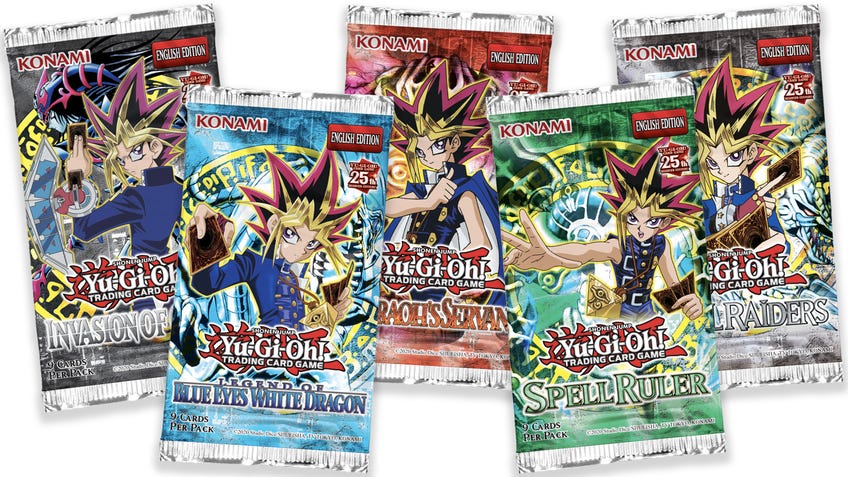
Even if these experiences did bring new players to the game and offer an accessible entry route into playing Yu-Gi-Oh! for many, how does this explain why 2023 in particular was a more accessible year for those wanting to give Yu-Gi-Oh! a chance? Beyond the return of an uninterrupted competitive circuit and the community of card shops for in-person competition, that is.
This comes from the commendable actions taken by Konami to accelerate moves to democratise and lower the financial cost of entry to competitive TCG Yu-Gi-Oh! for those looking to take the plunge. In other years it would be understandable for a person to express interest in playing, only to baulk at the high cost of initial investment in building a deck that can compete with the best in the game. This issue has been addressed in a few ways.
Yu-Gi-Oh! is entering 2024 and its anniversary in the healthiest state the TCG has enjoyed throughout its post-COVID existence.
Reprints are one obvious avenue improving the financial state of the game for new players. The 25th Anniversary Rarity Collection has set a new standard for how to make the core cards of the game more accessible through multi-rarity print runs and card selection. Structure deck releases have similarly included not only common reprints of staple cards used across all decks due to their versatility but have stood out in comparison to prior years for their strength. The recent Reloaded Fire King structure deck is a particularly impressive release, promising a deck that can compete in tournament events just by picking up three copies of the deck and merging them together.
The Sacred Fire Kings in the deck centre their effects around destruction, driven by the primary boss monster featured on the packaging, Sacred Fire King Garunix, a card which can special summon itself from the hand and further its combos by destroying monsters from the deck if successful. It makes things easier than ever for new players, only helped by plans to release a new two-deck Starter Set in January that allows you to team up with a friend and learn the ropes with two pre-built decks in a single set.
Coupled with the balance in the current metagame making more decks than ever a viable strategy for competitive glory, it gives players the remit to play just about anything provided they have the strategy and skill to upset and overcome an opponent. It’s a far healthier state for the game than even that seen towards the end of 2022 and start of 2023 when the domination of Kashtira and Tearlaments left little space for other decks to compete. With more competition comes a more level and exciting competitive game for newcomers and veterans alike, which can only be a good thing.
Which leaves us entering 2024 and the game’s anniversary in the healthiest state Yu-Gi-Oh! has enjoyed throughout its post-COVID existence. From a time when the game struggled we can look back on the game’s success and see a path forward for another 25 years. Nostalgic fans can enjoy the past via collectible releases and the Legendary Collection and, from that, feel capable of diving into the modern game in a way that was once too intimidating or expensive for many to fully enjoy.
Ultimately, a game can’t sustain itself on the goodwill of long-term players forever. A key stumbling block for Yu-Gi-Oh! has been its lack of an entry point for new players. An anniversary year will naturally garner attention for the franchise, and the upcoming Tokyo Dome showcase and celebratory releases are just the start of what promises to be a big year worthy of that increased scrutiny.
This means nothing if the game can’t capitalise on that to find new strength. For the first time in a long time, thanks to its digital and physical reforms, it feels like Yu-Gi-Oh! is putting its best foot forward at the most crucial time.
